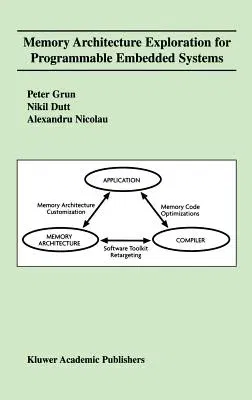Continuing advances in chip technology, such as the ability to place
more transistors on the same die (together with increased operating
speeds) have opened new opportunities in embedded applications, breaking
new ground in the domains of communication, multimedia, networking and
entertainment. New consumer products, together with increased
time-to-market pressures have created the need for rapid exploration
tools to evaluate candidate architectures for System-on-Chip (SoC)
solutions. Such tools will facilitate the introduction of new products
customized for the market and reduce the time-to-market for such
products.
While the cost of embedded systems was traditionally dominated by the
circuit production costs, the burden has continuously shifted towards
the design process, requiring a better design process, and faster
turn-around time. In the context of programmable embedded systems,
designers critically need the ability to explore rapidly the mapping of
target applications to the complete system. Moreover, in today's
embedded applications, memory represents a major bottleneck in terms of
power, performance, and cost.
In particular, Memory Architecture Exploration for Programmable
Embedded Systems addresses efficient exploration of alternative memory
architectures, assisted by a "compiler-in-the-loop" that allows
effective matching of the target application to the processor-memory
architecture. This new approach for memory architecture exploration
replaces the traditional black-box view of the memory system and allows
for aggressive co-optimization of the programmable processor together
with a customized memory system.
The book concludes with a set of experiments demonstrating the utility
of this exploration approach. The authors perform architecture and
compiler exploration for a set of large, real-life benchmarks,
uncovering promising memory configurations from different perspectives,
such as cost, performance and power. Moreover, the authors compare the
Design Space Exploration heuristic with a brute force full simulation of
the design space, to verify that the heuristic successfully follows a
true pareto-like curve. Such an early exploration methodology can be
used directly by design architects to quickly evaluate different design
alternatives, and make confident design decisions based on quantitative
figures.
Memory Architecture Exploration for Programmable Embedded Systems is
designed for different groups in the embedded systems-on-chip arena.
First, the book is designed for researchers and graduate students
interested in memory architecture exploration in the context of
compiler-in-the-loop exploration for programmable embedded
systems-on-chip.
Second, the book is intended for embedded system designers who are
interested in an early exploration methodology, where they can rapidly
evaluate different design alternatives, and customize the architecture
using system-level IP blocks, such as processor cores and memories.
Third, the book can be used by CAD developers who wish to migrate from a
hardware synthesis target to embedded systems containing processor cores
and significant software components. CAD tool developers will be able to
review basic concepts in memory architectures with relation to automatic
compiler/simulator software toolkit retargeting.
Finally, since the book presents a methodology for exploring and
optimizing the memory configuration for embedded systems, it is intended
for managers and system designers who may be interested in the emerging
embedded system design methodologies for memory-intensive applications.

